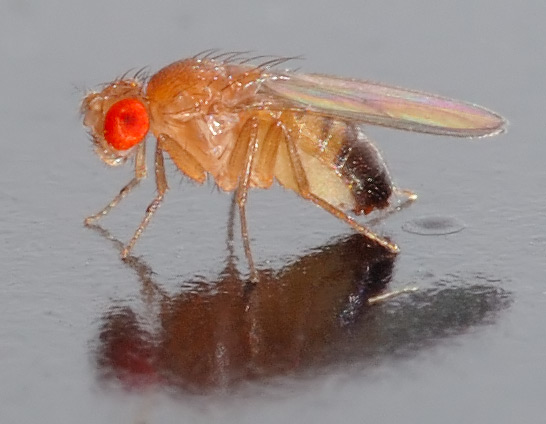Spotted wing Drosophila found in south central Kentucky
Posted on Sep 26, 2012“For years to come, this is going to be a major production issue for raspberries, blackberries, blueberries, grapes and strawberries,” said Ric Bessin, extension entomologist with the UK College of Agriculture.
Other fruits such as tomatoes, pears and apples are less susceptible to the damage of the pest, unless the skin of these fruits is already broken or damaged.
UK entomologists have been monitoring for this pest after it appeared two years ago in several neighboring states.
Since a spotted wing Drosophila fly resembles other fruit flies found in Kentucky, it is important to properly identify the specimen collected. Small in size, the pest ranges from 2 to 3.5 millimeters in length. The spotted wing Drosophila also has red eyes. A male will have a black spot on both of the wings, along with small black bands on the front legs. Females will have an ovipositor, also known as an egg layer. Unlike the male, a female does not have any markings on its wings or front legs.
Typical fruit flies lay eggs on fruit that is already damaged or rotted, however, the female spotted wing Drosophila can lay eggs under the skin of ripening fruit with her ovipositor. Although the fruit may appear healthy, internal damage from larvae will destroy the fruit.
The spotted wing Drosophila completes its life cycle in less than two weeks. Each year, there can be 10 or more generations, with females each laying 200 to 600 eggs.
Fast reproduction can lead to the rapid increase of this new pest in Kentucky. Bessin said there is a possibility that the spotted wing Drosophila could already exist in other parts of the state.
Not only can this pest damage fruits, there is also a growing concern for the possibility of it having negative effects on households as well.
“This will also be a big pest for homeowners as well since it can lead to fruit fly problems in the house when produce is brought in from the garden,” Bessin said.
To help control the fly population, producers should dispose of any fruit that appears to be damaged or rotted in the growing area. This will help avoid the possible accumulation of pests around healthy fruit. If producers suspect the production area is hosting the damaging pest, they should create a fruit fly trap to monitor insect activity.
To construct a fruit fly trap, hang a clear container with a lid in the growing area. To allow insects to enter the trap, punch holes below the rim of the cup. Pour apple cider in the bottom of the trap to lure the pests, and hang a yellow sticky card inside of the plastic container to catch flies that enter. The fruit fly trap should be monitored frequently.
To prevent the spotted wing Drosophila fly from harming future fruit crops, taking action before harvest will reduce the risk of the pest damaging the fruit as it ripens. Since fruit producers may not know the extent of damage until harvest, spraying with an approved insecticide before harvest can reduce the risk of losing a crop.
For more information about controlling the spotted wing Drosophila fly, producers can view UK Cooperative Extension publication ID-94, Midwest Small Fruit and Grape Spray Guide, or contact the local county extension office. Extension agents can assist producers with specimen identification.
Source: Press release courtesy of UK College of Ag
Tagged Post Topics Include: Commodity, Extension, Pests, UK

Comments